
[ad_1]
The researchers have created an edible battery by utilizing riboflavin and quercetin as anode and cathode, respectively, with activated charcoal to enhance conductivity and nori seaweed as a separator.
The emerging field of edible electronics has promising implications for diagnosing and treating gastrointestinal tract diseases and food quality monitoring. However, one of the main challenges in this field is the development of edible power sources.
A team of researchers at the Istituto Italiano di Tecnologia (IIT-Italian Institute of Technology) have developed an entirely edible rechargeable battery using materials commonly consumed in our daily diet. The potential uses for this technology include health diagnostics, food quality monitoring, and edible soft robotics.
The researchers used activated charcoal to increase conductivity and nori seaweed as the separator in developing an edible battery that uses riboflavin and quercetin as anode and cathode, respectively. Beeswax encapsulated the electrodes with food-grade gold contacts on cellulose-derived support. When ingested, the battery operates at a safe 0.65V and can power low-energy devices like LEDs for up to an hour with a current of 48μA for 12 minutes or a few microamps. This first-ever fully edible rechargeable battery paves the way for new edible electronic possibilities.
Edible circuits and sensors for monitoring health and food storage conditions are among the potential uses of the new fully edible rechargeable battery. Its high level of safety makes it suitable for use in children’s toys. The researchers are also developing smaller devices with greater capacity, which could power edible soft robots.
The edible battery has potential for the energy storage community as it is a safe alternative to toxic materials used in batteries. Although it cannot power electric cars, it proves that safer materials can be used in batteries. This development could inspire other scientists to build batteries for a sustainable future.
Reference : Ivan K. Ilic et al, An Edible Rechargeable Battery, Advanced Materials (2023). DOI: 10.1002/adma.202211400
[ad_2]






